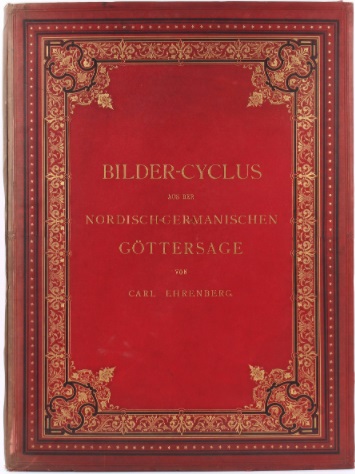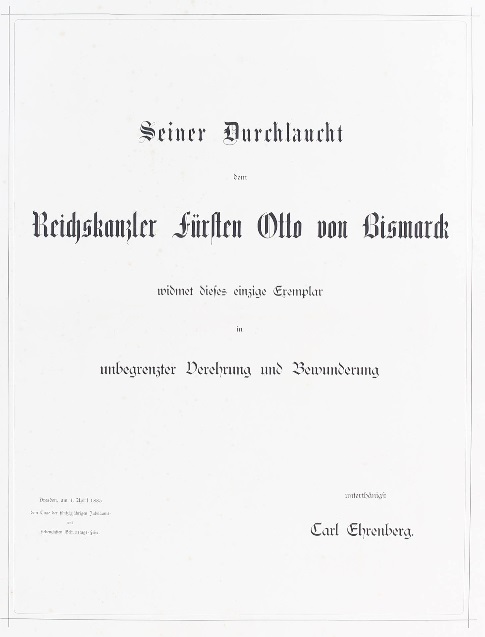Carl Ehrenberg (1840-1914)
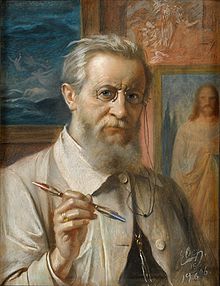
Self portrait 1906
THE LOST MASTERPIECE
Bilder-Cyclus aus der
Nordisch-Germanischen Göttersage
"Picture-Cycle from the Nordic-Germanic Godsaga"
[HOME] [POPULAR RETELLINGS]
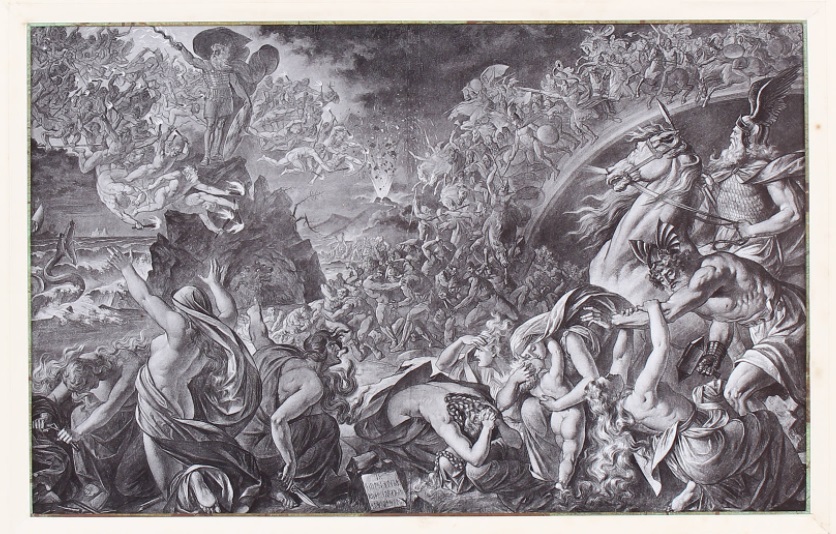 RAGNARÖK, THE TWILIGHT OF THE GODS |
||||||
| HIS LIFE | ||||||
|
Gottfried Ferdinand Carl (sometimes Karl) Ehrenberg, German painter and illustrator, was born in the villiage Dannau bei Oldenburg in Holstein on 6 November 1840 and died in Dresden, 1914. The son of a master upholsterer (Tapeziermeister), Ehrenberg spent his childhood as a shepherd before earning an apprenticeship as a painter. He studied painting at the Royal Danish Academy of Art in Copenhagen with financial help from the Oldenburg family. After four years, he continued his studies in Dresden from 1862 with Julius Hübner and then with Julius Schnorr von Carolsfeld. In 1866, he met some English ladies in Dresden who invited him to London in the summer of 1866, where he created "Drawings of the Lower Classes", which he exhibited in the Kiel Art Gallery. After the collapse of the Danish state and before the incorporation of Schleswig-Holstein by Prussia, the prospect for visual artists in his home country was bleak. Ehrenberg joined an initiative by the poet Klaus Groth to help struggling artists. Ehrenberg was one of the first from Schleswig-Holstein to travel to Rome on a Prussian scholarship in October 1867, and in March 1868, he visited Capri, where Ehrenberg gained the friendship of Friedrich Oberbeck, which led to a recommendation, extending his scholarship. His masterwork "Let the Little Children Come to Me" found a place in the stairwell of the rectory of the Protestant Church in Via Toscana. In 1868, he painted a portrait of Franz Liszt, his most famous work. In addition to Liszt, he also painted a portrait of Princess Feodora of Schleswig-Holstein-Sonderburg-Augustenburg. During the Franco-Prussian War, he took part as a nurse. After stays in Munich and Antwerp, he worked in Dresden permanently after 1875. In 1881, he became a member of the Free German Hochstift. As a draftsman, he illustrated works of history and authored works himself under pseudonyms. Ehrenberg's historical paintings treated Germanic mythology and religious subjects. He married the concert singer and vocal instructor Sophie Elise Johanne Georgine Langheim (born 1848, died July 22, 1892 in Dresden). They had two sons, Paul and Carl Ehrenberg. After the death of their mother, they both grew up in the Villa Distelheim of the archivist Theodor Distel in Blasewitz. In Dresden, Ehrenberg created twelve cartoons depicting the gods and goddesses from the Germanic godsaga, published in 1885 as Bilder-Cyclus aus der Nordisch-Germanischen Götter-Sage with two sheets of explanations by Dr. Wilhelm Wägner. The first six charcoal drawings had already been published by Gilbers in 1882. These illustrations, comprising two picture cycles on Nordic-Germanic mythology, date from 1880/81 and 1882/83. These cartoons served as the design for a cycle of murals (wandbilder) executed in Dresden. A full description of this work can be found in Dr. Paul Hermanowski's Die Deutsche Götterlehre und ihre Verwertung in Kunst und Dichtung, Volume 2 (1891), pp. 52, 197-208. The text below is based on that account. The author does not provide the exact location of the work. Sketchs of some of the original paintings, reproduced in later works such as Wilhelm Wagner's Nordisch-Germanische Götter und Helden: in Schilderungen für Jugend und Volk (1882), have been included here. |
||||||
HIS ART
The Gods of the Nordic-German Myths. Six large cartoons on 2 groups of arches. Source: Friedrich von Boetticher. Malerwerke des Neunzehnten Jahrhunderts, Vol. 1, 1891. |
||||||
|
||||||
| All the gods and goddesses can
be found on these twelve cartoons from the Germanic godsaga.
First we see Odin on his high seat, his left hand wrapped in his
long, full beard hair. His face is that of a strong, mature, but
not old, man. A winged helmet covers his head which is turned
sideways so that his missing eye cannot be seen. His arms are
bare, a belt closes the armor over his long, wide robe. His
right hand is placed on the arm of the throne; next to the left
hand is his spear. Two ravens whisper news in his ears. At his
feet are the two wolves. |
||||||
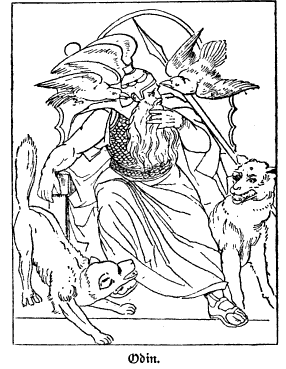 ODIN Reproduction from Allgemeine Götterlehre (1890) |
||||||
|
On the same cartoon, also on a larger sheet, there is Odin's
oldest and strongest son, Thor, sitting naked on a throne, the
back of which is adorned with a goat's head. He holds the hammer
in his right hand. Ears of grain are below it. His beard and
hair are short but curly and wavy. While a deep, calm
seriousness gazes on Odin's face, Thor's face is somewhat dark,
almost surly. With his left hand he grips the shoulders of his
young, but strong, son Magni, who looks up to his mighty father.
|
||||||
|
In the first zwickel (a space located between two
side-by-side arches), which fills the top left corner of the
cartoon, the primal-giant Ymir is drawn, very small, due to the
limited space. In the middle zwickel between the two main
pictures, we see Ask and Embla, the first human couple; in the
right corner, Buri, the man licked out of the salty ice blocks
by the cow Audhumbla. In the following box, the first main picture shows Tyr and Heimdall. Next to the god of battle, who is provided with a byrnie, lies his helmet and his mighty round shield. In his left hand he holds a short double-edged battle sword. His look is dark and challenging. His face, fringed with dark hair and beard, has the features of a man of a more mature age, but Heimdall's figure is almost youthful. He has his right foot on a stone and wields the sword in his right hand, peering out as if he sees a dreaded enemy approaching. In his left hand, he holds his curved horn. A low helmet covers his head and a short robe covers his body. |
||||||
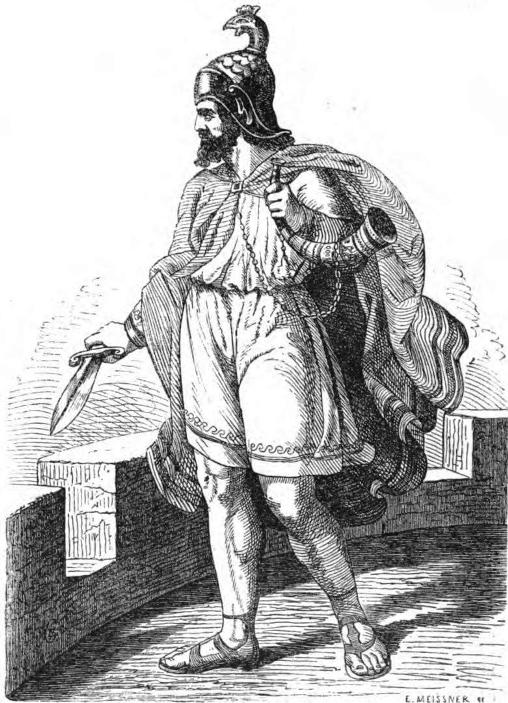 HEIMDALL Reproduced in Wilhelm Wagner's Nordisch-Germanische Götter und Helden: in Schilderungen für Jugend und Volk (1882) |
||||||
|
In the second main picture on the right, we see Vidar and Uller. Vidar the strongest after Thor is a powerful male figure. He is only partially dressed. With his right hand, he adjusts his “thick shoe” around his right foot. He already has footwear on the left one. Next to him, Uller is depicted sitting, as a young man, also barely dressed, which doesn't fit the wintry god of hunting who runs across ice-fields on snowshoes. He should have been shown wrapped in furs and provided with ice skates because he is the snowshoe god. The painter has not forgotten the yew bow that is his due. The god holds it in both hands. A quiver with arrows hangs over his back, next to him is his oval-shaped shield. In the left corner picture, Gefion is shown with a plough in her left hand. |
||||||
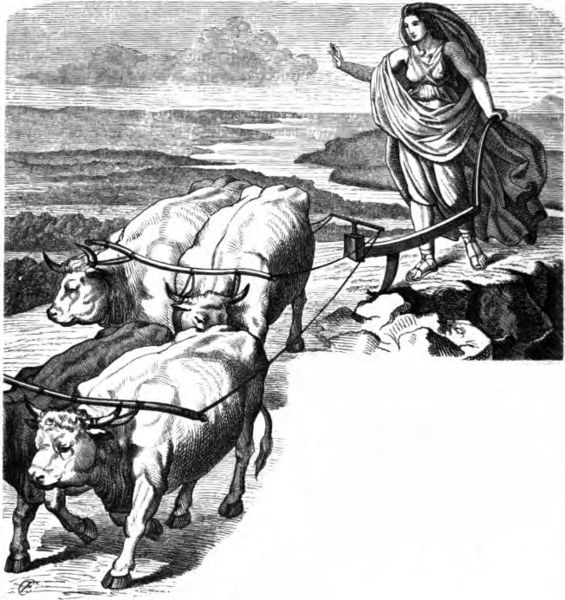 GEFION Reproduced in Wilhelm Wagner's Nordisch-Germanische Götter und Helden: in Schilderungen für Jugend und Volk (1882) |
||||||
|
In the middle zwickel, we see Valkyries armed with
helmets, byrnies, shields and spears, storming through the
clouds on their horses. |
||||||
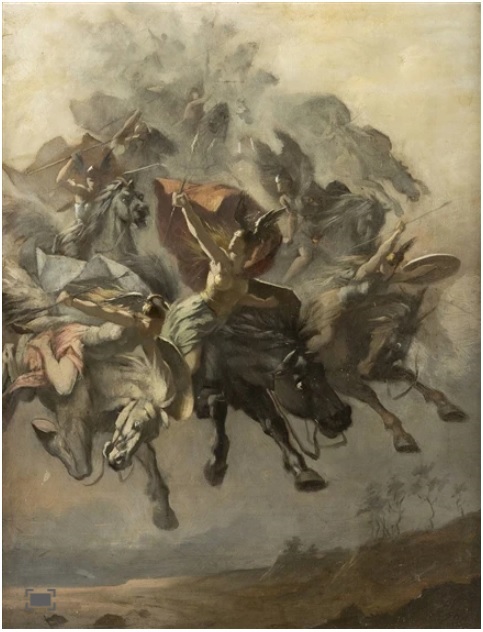 VALKYRIES unfinished, oil on canvas |
||||||
|
In the right corner
picture, Sif, Uller's mother, thoughtfully supports her head
with her left hand, holding ears of corn in her right hand.
In the next box, we find Freyr and Gerda in the first main picture. A crown helmet adorns the curly head of the youthful god, adorned with a sparkling star. A short cape covers his pleated robe. He raises his right arm in the air under which fruits and flowers of various kinds can be seen in abundance. Dwarves play at his feet. They built his miracle ship Skidbladnir for him, they also let growth sprout out of the earth's bosom. With his left hand, Freyr holds a ribbon-like bridle. A costly ship-like wagon, drawn by a boar, stops. Behind Freyr stands Gerda, whom he won for his wife through Skirnir. Her dazzling white arms are adorned with hoops. She holds her right hand over her eyes to better see into the distance. Her hair, adorned with a diadem, falls down her back in long curls. In her left hand, she holds a flower garland. |
||||||
 FREYR and GERD A similar picture attributed to Ehrenberg, reproduced in Wilhelm Wagner's Nordisch-Germanische Götter und Helden: in Schilderungen für Jugend und Volk (1882) |
||||||
|
In the second large picture, we see Niördr and
Skadi. Niördr, as the god of the sea favorable to navigation,
holds an oar in his left arm. His hair is wreathed with reeds. A
white beard falls on his chest. In the background, a ship, whose
sails have swelled with wind, sails over the water. The god of
the sea is rich, because in its depths infinite treasures are
hidden. In the picture, therefore, we see dwarfs bringing gold
and jewelry, and putting them in boxes. Shells lie on the
ground. Skadi, who stands on Niörd's right side, holds a
“magpie” (elster; OHG scado, see Grimm TM, p.
675 Stalleybrass tr.) whose name she bears in her left hand. A
hunting dog greedily looks up at her and she holds out her right
hand. The goddess is not drawn austere enough. She is a bold
hunting goddess, who chases after the wild with the bow on
snowshoes, who therefore does not like the calm, peaceful
Niördr, who shies away from the rough mountains and howls of
wolves. The natures of both spouses are so different, they soon
separate. |
||||||
|
In the left corner picture, Skirnir is drawn with
Freyr's sword in his right hand. In the middle zwickel, we see
three hovering elves playing. Eir, the goddess of healing, is
surrounded by long, thin veils in the right corner picture,
holding medicinal herbs with her left hand. In the following box we find the light god, Baldur, in the first main picture, with his wife Nanna. Both their heads are wreathed with flowers. They are beautiful figures, bright and youthful. Nanna hugs her husband lovingly and he holds her. A draped mantel falls over Baldur's light undergarment. Nanna's robe is wide and long, a delicate veil hangs down over her back, and over it lies her hair in abundance. Next to the couple is their little son Forseti, almost naked. Baldur holds his right hand on the boy's shoulder, which the child takes tenderly. |
||||||
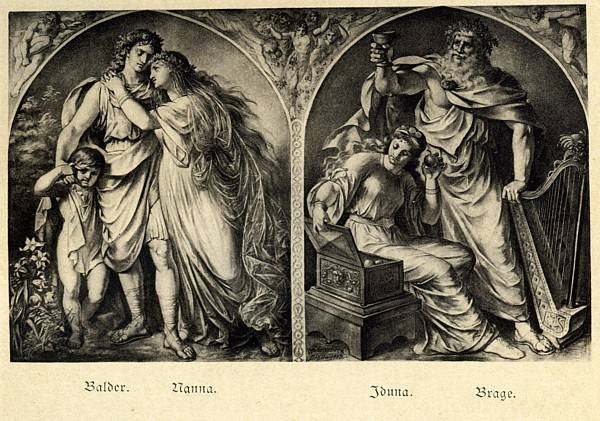 |
||||||
|
In the main picture on the right, we see Bragi and Idun.
The latter is depicted as a bearded old man, his head wreathed.
In his right hand, he happily holds a wine goblet, the left
leaning on the harp that stands next to him. A long, wide
robe covers him. Idun sits in front of him by a box
containing her rejuvenating apples, one of which she has taken
out with her left hand, while her right holds the lid. Her long
dress is tied with a belt, her full hair is adorned with a
diadem-like clip. She is young and beautiful adorn the arms.
In the left zwickel, we see Hödur who killed Baldur. He is naked, his left hand is clenched into a fist; his dark, already-aged features, and his closed eyes are intended to express his contrast with Baldur's bright nature. In the middle zwickeļ, a number of Hamingias or Fylgias float; in the right corner picture, we see Hermodr who undertook a ride to the underworld, perchance to set his brother Baldur free from Hel. In the following box, the first main picture depicts Frigg. The queen of the gods is painted too young. Nor does she seem to be the protector of domesticity and women's work, but rather she stands upright as if armed for battle, next to her throne, on the arm of which she rests her left hand; in her right, she holds a spear. A precious ring adorns her short hair. A rich dress envelops her; a short cloak is thrown over her shoulders. A Valkyrie, who holds a horse in front of the entrance, seems to urge her to join the fight. Fulla kneels in front of her with a gold ribbon wrapped around her loose hair and holds an open jewelery box out to her mistress. A female figure, pleadingly grabs Frigg's spear. |
||||||
|
In the main picture on the right, we see Freyja, a
beautiful female figure with lovely features. With her right
hand, she grasps her shiny necklace, Brisingamen, which is made
of pearls. Around her left arm, a servant has just placed a
precious circlet; another is busy with her left shoe; a third
kneels and holds up a helmet adorned with mighty wings to put
on. Then, she will probably hand her the spear, still at her
feet. |
||||||
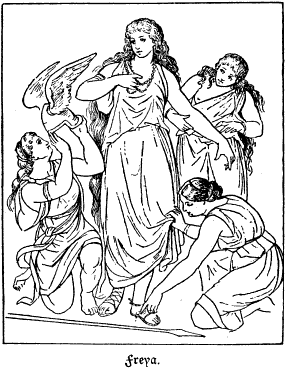 FREYJA Reproduction from Allgemeine Götterlehre (1890) |
||||||
|
In the left corner, we see Var, who hears vows that unite men and women. Therefore, a child lies next to her, as she plays with an apple. The three Norns are drawn in the small center picture. In front, Verdandi sits, recording what has happened; Urd on the left, chasing away what has happened with her hands raised, and on the right, Skuld, looking towards the future with her veil lifted. In the right corner picture Snotra, is given without any characteristic. |
||||||
|
The second main picture shows us the third creature of Loki's hideous brood, namely Hel. She sits at the entrance to her realm. Her features, with which she looks at newcomers, are grimly distorted. She points a crowd of those who have fallen into disrepair, toward the deeper levels, with her right hand. With horrified faces, they float past their terrible mistress. The snapping hellhound, Garm, has his front paws on Hel's lap and right leg; his mouth is open. He bares his teeth to the silent guests, who are near. A strong iron diadem covers Hel's black-haired head. The left side of her face cannot be clearly seen —it should be dark in color. |
||||||
 |
||||||
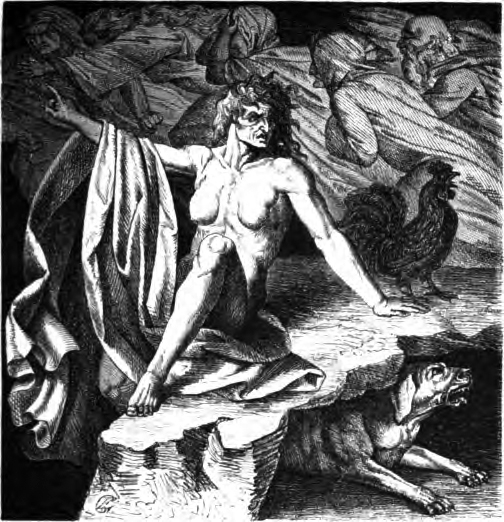 Variant of Hel nude with Dog and Rooster. |
||||||
|
In the small corner picture on the left, we see the
giant Hräsvelgr with eagle wings, with which he makes the wind.
The lack of space makes him appear too small. The middle picture
is Ægir and Ran, the deities of the stormy, perilous sea, poorly
drawn in clear outlines. Fish swim around them and you can see
from the aquatic plants that they are at the bottom of the sea.
They both grab a chain-like anchor rope to pull a ship into the
deep, Ran with glee on her face. Both figures are naked. On the
right corner picture we find Logi, naked, lightning flashing
from both hands, holding the wild fire in front of him. While these first six boxes presented the individual gods and goddesses, more important scenes from the godsaga are shown in the following six: |
||||||
|
Picture-cycle from the
Norse-Germanic Godsaga. Six large cartoons, Koblenz. The cycle appeared as 6 collotype illustrations with text by Wilhelm Wägner, Dresden, 1882. Source: Friedrich von Boetticher. Malerwerke des Neunzehnten Jahrhunderts, Vol. 1, 1891. |
||||||
|
||||||
|
The first illustrates the Van-goddess Freyja's admission among the Æsir, who like her brother Freyr and her father Njördr, was given as a hostage and came to Asgard, at the conclusion of the war between Æsir and Vanir. When the beautiful goddess of love steps into the circle of the Aesir, everyone is amazed. Freyja is surrounded by elves wearing floral garlands and jewelry; one of them, with butterfly wings, is just lifting the veil from her head and face. Precious pearl jewelry adorns the goddess's neck. Almost all the Æsir are gathered when Freyja appears. On his high seat, the back of which is decorated with wolf heads, Odin is enthroned with his right hand on one of his wolves, who shows strangers his teeth threateningly. His two ravens are here on the steps of the throne at his feet. A short cloak is thrown around his shoulders, a helmet covers his head, which he benevolently turns to the beautiful goddess. A long scepter stands next to Odin in his right hand, the left hand offering a welcome, while she listens to Odin's greetings. Behind this pair of gods, Thor stands with his arms crossed, like Odin unarmed, even the bare head is also provided with a short cloak. To Frigg's left stands old Bragi, his right hand leaning on his harp, his left hand gripping his full beard, his head wreathed. In the middle, right behind the Asynje, stands the light Baldur with flowers in his hair and to the left of him, a little more in the background, Loki insidiously glances sideways at the new goddess. Behind Freyja is old Niördr with a long beard, his head wreathed with reeds and a mighty cornucopia in his right hand. On his left stands Freyr, covered with the helmet that adorns a boar's head, his right hand on his armor, with his left hand gripping the pommel of his sword, as if by this he wanted to show that he was determined and ready to protect his sister against any injustice. |
||||||
|
The second box is labeled: “The Valkyries”. We see a battle raging on the seashore to the left. Boats bring even more fighters. There are many heroes who have been struck to death. The battle virgins have plenty to do. Two in the foreground are lifting a warrior, who is laying his left hand on the death wound in his chest, from the stumbling horse, to carry him to Valhalla, toward whose brightly shining gates countless heroes are already riding through the air, guided by Valkyries. Other Valkyries float lifted on swan wings, holding wreaths of glory in their hands. All Valkyries are adorned in helmets with swannecks and wings. They wear byrnies; many also have spears and shields. One in the foreground is lifting a hero, who has fallen to the ground, to ride to Odin's hall. Helmets, shields, and hewn weapons cover the floor. |
||||||
 VALKYRIES Reproduction from Allgemeine Götterlehre (1890) |
||||||
|
The heroes who have entered Valhalla are called Einherier. Here one can expect joyous bliss. There is never a lack of mead and the joys of the meal that they loved on earth —here, they have it in abundance. The next box is labeled “Feast in Valhalla”. At long tables we see the heroes with the Aesir, drinking and feasting, served by Valkyries who draw mead from a large cauldron in the middle. New guests, to whom Valkyries hand wreaths of glory, arriving from the host, are welcomed with foaming cups and horns. On his perch in the middle, Odin sits with his spear Gungnir in his right hand, while his left hand holds a goblet in which a winged Valkyrie pours wine. The wolves below are eating the meat. The two ravens sit on the back of the armchair. Bragi's harp is not missing from the table, and a Valkyrie holds such a stringed instrument. |
||||||
 VALHALLA |
||||||
|
But one of the Æsir is missing from the table: Thor. He's on an expeditions against the giants from "Thor battles with the Jötuns". Standing in his chariot with two flaming wheels, which his two goats pull, he rides over the clouds. In front of him rises a mountain made up of giants' bodies. Other giants hurl pieces of rock at him. But Thor undauntedly throws his crushing hammer to bring down the lightning so that the living wall of men quakes. He will crush them. The god has put on the iron glove; the belt of strength encircles his body. In wide, bushy folds, a long coat flutters behind him, comparable to dark clouds. —On the left, warm rays fall from above to soften the ice blocks; fertilizing thunderstorms rain: the previously hard ground soon sprouts the grain, which two figures floating in the air already hold up as a product of the two beings that give warmth and fertilizing moisture. |
||||||
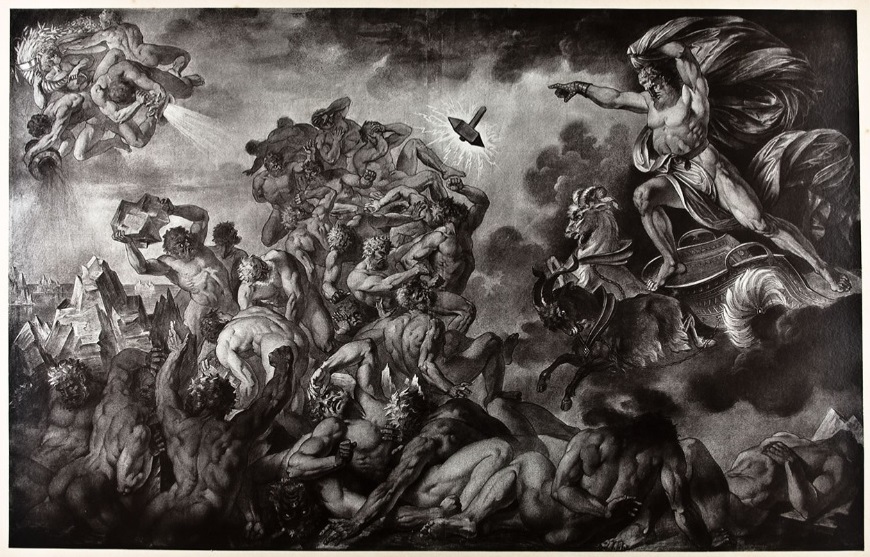 THOR BATTLES WITH THE JÖTUNS |
||||||
|
The next box shows “Hermod Requesting the Release of
Baldur from Hel.” Baldur had been
killed by Hödur, at Loki's instigation, with the mistletoe and
had to go down to Hel. His wife Nanna accompanied him. All gods
and goddesses are saddened, especially his mother Frigg. To
quench her tears, Hermodr has offered to ride to Niflhel on
Odin's steed, perhaps to beg Baldur to leave the underworld
goddess. It took him nine days to reach his goal. Now he is
standing in front of the steps of Hel's throne, wearing a helmet
and short robe and coat. Dark and grim, she looks at him because
of his light complexion strangely contrasts with the ash-gray
bodies of the inhabitants of Hel's realm. Hel's upper body is
bare. Her hair falls on her neck. In her right hand, she has a
scepter wrapped with a snake. On the steps of her throne her
servants gather: Worry, Greed, Hunger, Indolence, Despair, and
Misery. "Misery” appears almost worn out and heavily pressed;
on the other side “Despair”, wrings his hands, and similarly
“Worry”. “Indolence” lays down in shameless idleness, “Hunger”
gnaws a bone and “Greed” attempts to tear it out of his mouth.
—The painter has personified Hel's attributes —Hunger is
actually her bowl, Greed her knife. The underworld appears
gruesome, especially the part on the left in the foreground
where snakes wind around the bodies of the damned. The hall formed by rocks seems to bulge immeasurably in the various sections of which we see the contorted faces of the wretched inmates. In the foreground on the right is Baldur, in front of his seat of honor, which is granted to him here. Nanna sits in front of him and hugs him lovingly. Baldur's head is still wreathed, but the blossoms and flowers are wilted; he looks woefully at Hermodr, who points to him with his right hand, while he looks up at Hel with lifted left hand, giving more emphasis to his request for the return of Baldur. We know Hel would allow Baldur to return if everything on earth, without exception, cried. Only the giant woman Thökk, who was Loki, did not. So Baldur remained with Hel. |
||||||
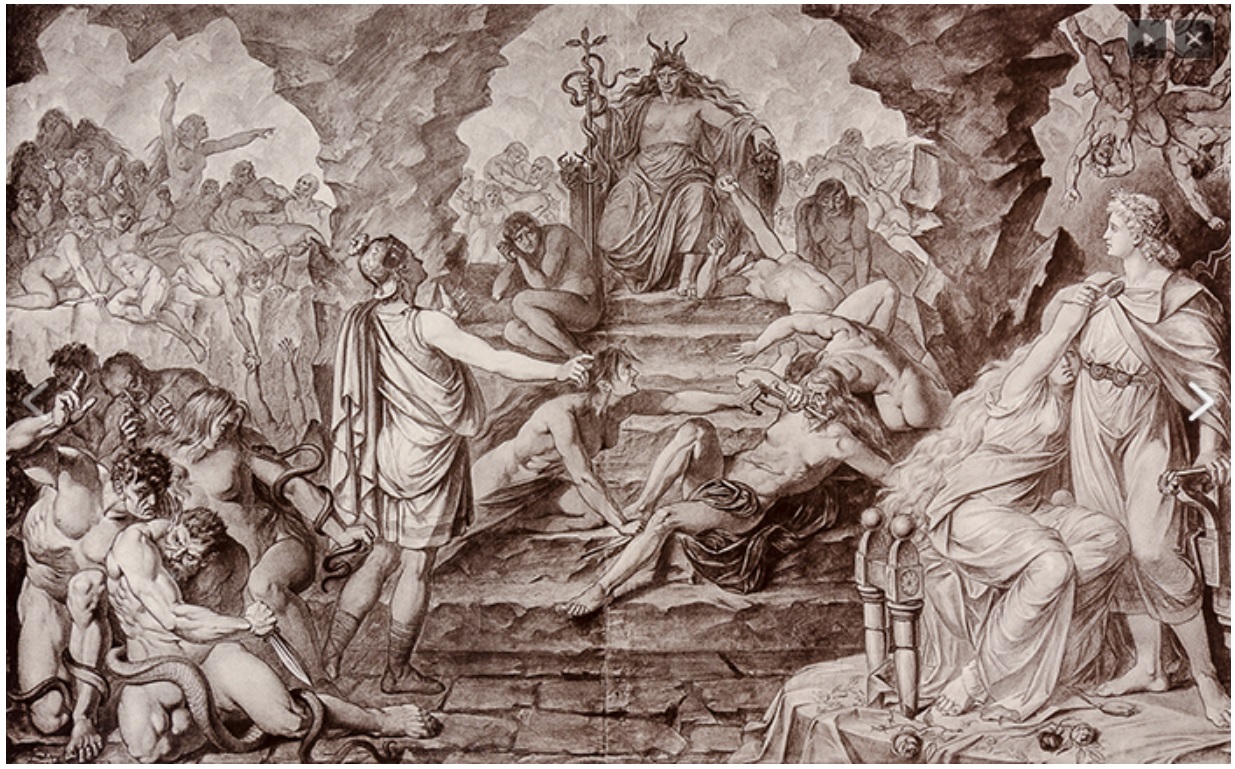 HERMOD REQUESTING THE RELEASE OF BALDUR FROM HEL |
||||||
|
The last box now represents the final battle, Ragnarök ,
“The Twilight of the Gods”. On the left, we see the
Midgard serpent rising out of the sea, so that the foaming waves
rise high, washing against and over the shore. In the distance
one can see the ship Naglfar sailing; above it, the sons
of fire soar through the sky, equipped with various weapons and
torches. Their leader, Surtur, shows them the way. He stands on
the top of a high, steep mountain with a shining sword, his left
hand leaning on the shield. Fire also shoots up out of the
earth. A volcano hurls lava and flames upward. Crowds of
warriors who head the call of Heimdall's Horn to fight come
riding over the rainbow bridge to the Vigrid plain, on which the
Einherier and Aesir oppose the hostile forces. The goddesses
lament, desperation marks their features and their gestures. But
resolve and determination lie on the face of Odin, who is
armored, on his white stallion with helmet, byrnie, and spear,
inspecting his troops and then turning against the terrible
Fenris Wolf. — Next to him, Thor rushes forward full of wrath.
His wife Sif, who clings to him, seems to want to hold him back.
But he cannot be held back. With the hammer in his iron-shod
right hand, his head protected by a helmet, he storms on because
his mortal enemy lifts her head gruesomely in the distance. He
wants to smash it. His belt of strength increases his power.
|
||||||
 RAGNARÖK, THE TWILIGHT OF THE GODS |
||||||
|
Two more pictures by the same
painter Karl Ehrenberg are “The Norns” and “For Valhalla”.
We see the Norns at the foot of the World Ash. Two swans swim in the primeval fountain in front of them. Urd, the oldest, painted as an old woman, is sitting at the edge of the water and carving runes into a staff so that the past does not disappear from memory. She is wrapped in a draped gray robe. Next to her sits Skuld, young in years, but with a serious face gazing into the future, whose veil seems to lift her upraised hand. She has a blank rune tablet next to her and a rune-cutting knife in her right hand, but it's not time to rist yet. —Above these two stands Verdandi, a beautiful virgin figure. While Skuld's head is wreathed, she holds flowers in each hand to spread and a wreath to give to contemporaries. It symbolically represents the struggle for the existence of the present. She is armed with a dagger and wears a winged helmet. Skuld's robe and hair are dark, like the future she symbolizes. Bright and light, on the other hand, are Verdandi's dress and hair, which flows down in abundance. |
||||||
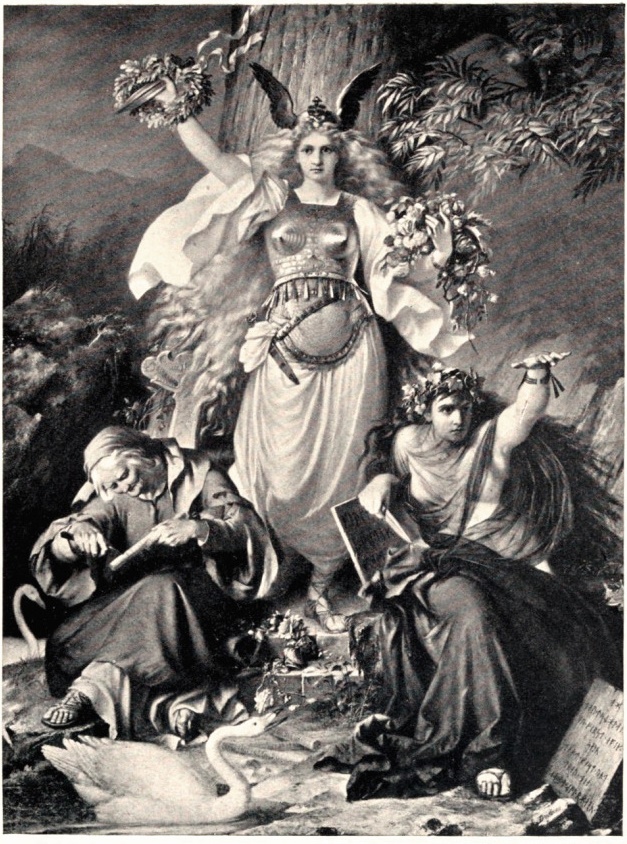 |
||||||
|
The picture “For Valhalla” shows two Valkyries, figures of magnificent women, leading a hero to Odin's hall. The warrior sits on a white steed. He already seems to see the shining castle in front of him. Because as if blinded, he holds his right hand over his eyes. A winged helmet covers his head on which the Valkyrie, who rides on a dark steed to his right, lowers the wreath of glory. A byrnie protects the fighter's chest, and on the left hangs his shield. His face shows ideally masculine, handsome features. The Valkyrie on the right swings her spear with her right hand, a helmet with mighty wings covers her head, and she looks at the hero with flashing eyes. The Valkyrie on the left walks alongside and holds the reins of the horse, carrying the hero with her right hand. She holds the spear in her left. A woman protects her upper body with a strong belt, a short battle sword hangs on the back of the shield. Her helmet is not decorated with wings. Ehrenberg went about the representation of the Germanic deities and the scenes from the life of the gods with passion. Some images of gods do not quite correspond to the idea that the reports give us about them. In general, we like his drawings, although we have to admit that he softened the harsh grandeur of the ancient gods and brought it closer to a more modern expression. A mixture of both that seems to us most evident in the last picture mentioned, “For Valhalla”. |
||||||
| Detailed description by Dr. Paul Hermanowski, 1891, translated from German and edited. | ||||||
|
Thank you for the inspiration Chandelier! |
||||||
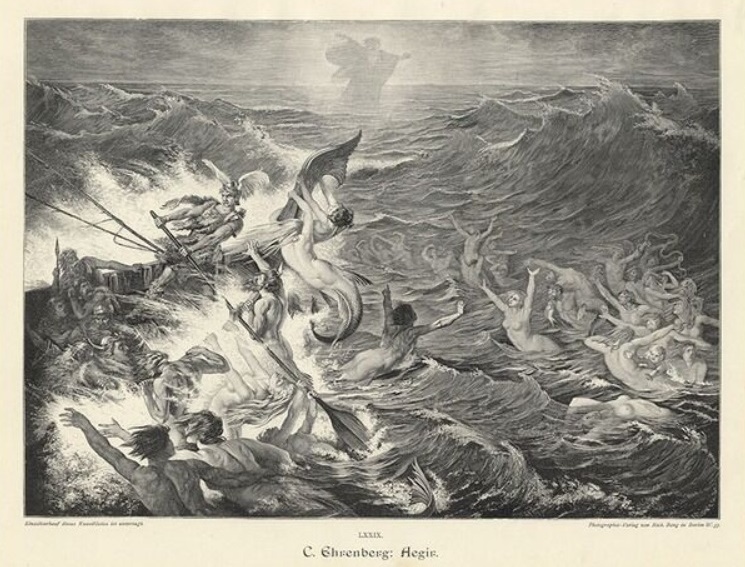 AEGIR |
